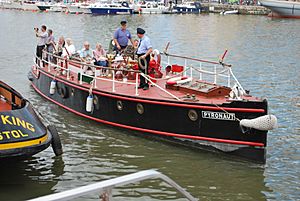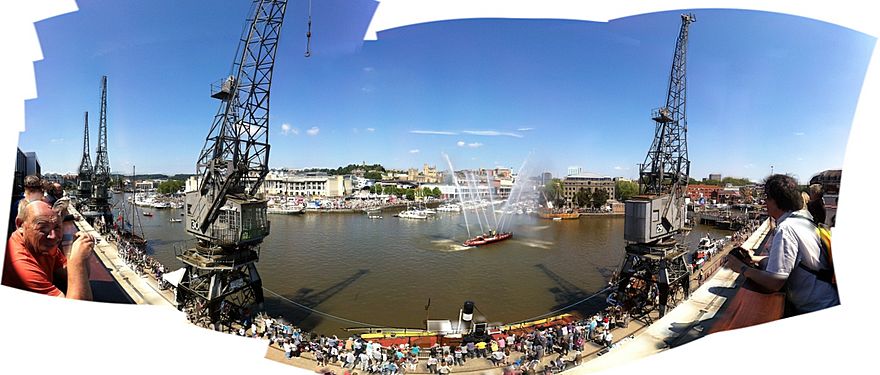Fire-float Pyronaut facts for kids
class="infobox " style="float: right; clear: right; width: 315px; border-spacing: 2px; text-align: left; font-size: 90%;"
| colspan="2" style="text-align: center; font-size: 90%; line-height: 1.5em;" | 
|} Pyronaut (originally named Bristol Phoenix II) is a special type of fireboat called a fire-float. It was built in 1934 by Charles Hill & Sons Ltd. in Bristol. This historic boat is now owned by Bristol Museums. You can find it at M Shed in Bristol's Floating Harbour.
When it was first built, Pyronaut had two Petter Atomic diesel engines. Each engine could produce 55 horsepower. It also had two Merryweather & Sons pumps that could spray 500 gallons of water every minute.
In 1968, the engines and pumps were updated. Two new Ruston & Hornsby diesel engines were installed. These were more powerful, at 90 horsepower each. They drove the propellers and also new Coventry Climax pumps. These new pumps could deliver 1000 gallons of water per minute.
Contents
| History | |
|---|---|
| Builder | Charles Hill & Sons Ltd |
| Launched | 1934 |
| Christened | Phoenix II |
| In service | 1934 |
| Out of service | 1973 |
| Renamed | 1938 |
| Homeport | Bristol |
| Status | Museum ship in Bristol Harbour |
| General characteristics | |
| Tonnage |
|
| Length | 55 ft (17 m) |
| Beam | 13 ft (4.0 m) |
| Draught | 3 ft (0.91 m) |
What are Fire-Floats?
Imagine many ships full of valuable goods docked close together. If a fire starts, it can spread very quickly. Land-based fire engines can help, but they can't always reach fires on the water. That's where fire-floats come in! These are special boats designed to fight fires from the water. Outside the UK, they are often called fireboats.
Early Fire-Fighting Boats
The very first fire-float was built in London in 1765. It was a small boat with a hand pump. The crew would row it to the fire. Bristol had a similar boat in the 1780s. For a long time, fire fighting in Bristol was done by private companies. The official Bristol Fire Brigade was formed in 1876.
By the mid-1800s, steam-powered fire-floats started to appear. Bristol's first was the Fire Queen, built in 1884. It was 53 feet long and had a steam pump. It could spray water through hoses or a water-cannon. The Fire Queen served until 1922.
In 1905, the Fire Brigade got the Salamander. It also used steam power. One day in 1917, a fire started at 7:30 a.m. The Salamander was called, but it took a long time to build up enough steam. By the time it arrived at 8:36 a.m., land crews had almost put out the fire. This showed that steam-powered boats could be too slow for emergencies.
Other boats in the port also had fire-fighting gear. These included the tugboat Brunel and the workboat Bulldog. The port also had the fire-float Denny, built in 1916. Denny worked until 1953.
New Fire-Floats for Bristol
In 1921, the Fire Queen was replaced by Phoenix. This new boat had a petrol engine, which was faster than steam. Ten years later, the Fire Brigade decided they needed even better boats. They ordered two new diesel-powered fire-floats. Charles Hill & Sons Ltd. in Bristol built both of them.
In 1934, the Bristol Phoenix II was launched. This boat was later renamed Pyronaut. In 1936, the Endres Gane was launched.
Bristol Phoenix II started work in June 1934. It was based at the Prince Street Bridge river police station. It had a crew of three firemen, including an engineer. The engineer worked below deck in the noisy engine room. He controlled the engines and pumps based on orders from the wheelhouse.
The Bristol Phoenix II helped fight many big fires. These included fires at saw mills, shipyards, and tar works. These places were far apart in the City Docks. To get to fires quickly, the boat had to pass under low bridges. This meant the boat's top part (above the water) was very low. The helmsman sometimes had to lie flat to steer under the bridges!
In 1938, the boat was renamed Pyronaut. This was because there was another boat named Phoenix on the Bristol Ship Register. A teenage boy, whose father was in charge of the Watch Committee, thought up the new name. Soon after, in November 1938, a big fire broke out at a malthouse. Pyronaut and land fire engines worked together to put it out. The fire caused a lot of damage.
Pyronaut During World War II
In 1939, Pyronaut was very busy. During the Bristol Blitz (air raids on Bristol), many buildings were damaged or destroyed. Pyronaut worked constantly during the worst raids. It helped fight fires in warehouses, factories, and homes around the Floating Harbour. It worked with two other motor-launches that also had fire-fighting equipment.
Peacetime Service
After the war, there were fewer fires, but Pyronaut was still needed. In 1948, a serious fire happened at the Hippodrome Theatre. Pyronaut pumped water from the nearby river. The fire happened during the pantomime season. Firefighters worked hard, soaked by water and smoke.
In 1949, Pyronaut helped fight a big fire at a paper mill. In 1950, it pumped water from the City Docks to fight a fire at a lead works. In 1951, there was a very serious oil fire at Avonmouth Docks. Pyronaut traveled down the River Avon and pumped water for two days straight! The next year, it fought a dangerous fire on a ship called Stalheim.
When things were quiet, the crew would practice with Pyronaut. They would take it out to learn how to use all the equipment. A favorite spot for practice was Beese’s Tea Garden.
Changes to Bristol City Docks
By 1967, Pyronaut's equipment was old and worn out. A new fire-float called Aquanaut was ordered for Avonmouth Docks. It was delivered in 1969. Aquanaut was very easy to steer. Its powerful pumps could deliver 2000 gallons of water per minute. It also carried foam to fight different types of fires. Aquanaut replaced the Endres Gane.
Instead of buying a new fire-float for the city docks, it was decided to upgrade Pyronaut. This happened in 1968 and 1969. Its old Petter engines were replaced with new Ruston & Hornsby diesels. New Coventry Climax pumps were also installed. The engines could now be controlled remotely from the steering position. This meant an engineer didn't always have to be in the engine room.
Pyronaut's Retirement
Even with the upgrades, Pyronaut's working days were limited. In 1969, it was announced that Bristol City Docks would close to large ships by 1975. A review in 1972 showed that most buildings could now be reached by land-based fire engines. So, Pyronaut was put up for sale in 1973. Seven years later, Aquanaut was also sold. Land-based fire engines and new tugs with fire-fighting gear took over.
Pyronaut was sold to the Port of Bristol Authority. They tried to turn it into a divers' boat. They removed the pumps and moved the engines. But the work was never finished. In 1983, it was sold again to a private owner. This owner wanted to use Pyronaut as a living boat in Ireland.
However, in 1989, the owner decided to sell the boat to Bristol City Museum and Art Gallery. Pyronaut was then restored and preserved. The work was finished in 1995.
Today, you can see Pyronaut outside the new M Shed museum. It is docked with the museum's tugboats, Mayflower and John King. Pyronaut is part of the National Historic Fleet. It performs exciting water displays at harbour events. You can also take trips on it during some summer weekends. In 2012, it even traveled to London for the Queen's Diamond Jubilee Pageant!


